Railgun is the new age’s technology, accelerating projectiles to insane speeds! Let’s build one [I’ll put it back up soon]:
Damn I thought it was much simpler to build. The concept is quite simple though. Let me give you a quick run down on magnetism:
- Magnetic fields are generated when electrons move from one point to another
- Magnetic fields are not just fixed lines of energy around magnets. The changes in the field actually spread at the speed of light. For example when you turn on current in a wire, you create circles of magnetic field around the wire and those circles start propagating into the universe at the speed of light, getting larger in radius as they go. And so the magnetic field gets weaker as the waves travel further.
- Every magnet has two poles, scientists named north and south. This is because the magnets, if freely floating, turn towards the earth’s poles. This is because earth is a giant magnet.
- Fun fact: earth’s north pole is the south of earth magnet! This is why it attracts north of permanent magnets.
- Scientists assigned a direction to magnetic force fields. They said the fields have a direction from north to south on the outside of a magnet. The field have to close though, which means inside a magnet the direction is from south to north. This is shown in the following picture from Wikipedia:
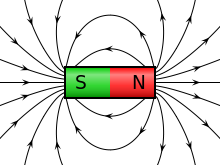
- Now when you run electric current inside a wire, you generate circular fields around the wire. The direction of these fields follows the first right hand rule I mentioned: if the right hand thumb shows the direction of current in the wire, then the remaining fingers show the direction of field around the wires. I is the current through the wire and B is the magnetic field in the picture below.
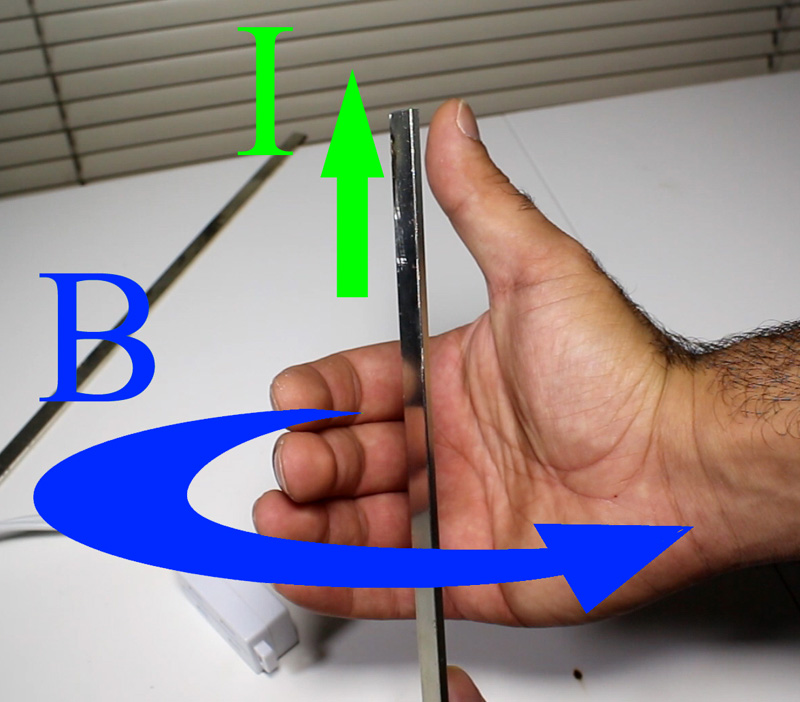
Magnetic field around a wire
- Now if you have a wire sitting in a magnetic field and run current through it, the fields interact with each other and this generates a force against the wire (Lorenz Force), as well as the original field. The second right hand rule shows the direction of the resulted force on the wire. Just listen to the right hand rule music and you would know! I is the current in the wire, B is the magnetic field of the original source and F is the force applied to the wire from the magnetic source.
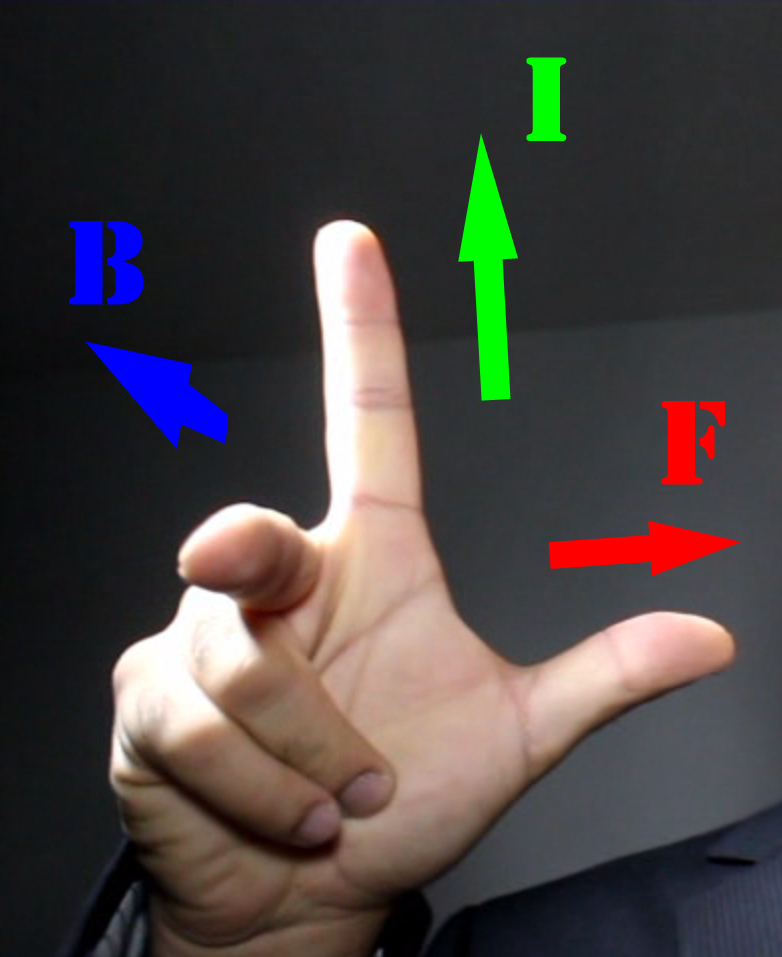
Force on a wire in a magnetic field
These should be enough for you to understand how a railgun supposed to work. According to Wikipedia it is quite simple:
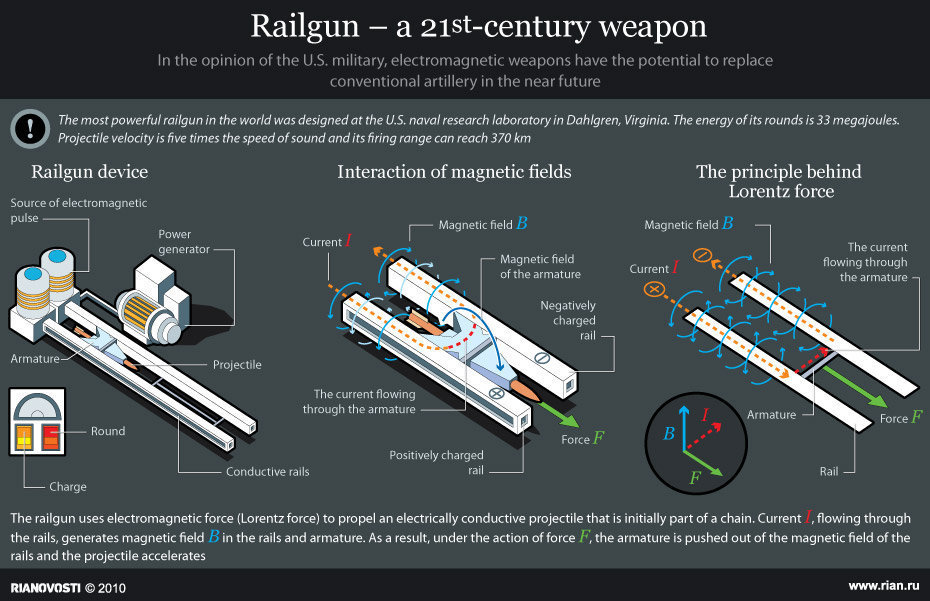
As I explained in the video, this should work for AC current too. Because in this system the current and field are related and if you apply the rules, the force ends up in the same direction: out of the loop.
But I think this schematic is OVER simplified! I cannot quite believe the theory works well for this application. If it is true, any loop of wire should expand as soon as high current runs through it. You saw in my video, I ran 313A through the damn wire and there is no sense of motion! The graphite piece didn’t move forward, it just rolled back under gravity. 313 damn amps! It can run very powerful motors, and yet it cannot move a tiny rod.
I think what the concept above is missing is that, the fields in fact end at the projectile and don’t exist beyond the projectile. This makes for a very small force, if any, on the projectile.
And WHY IN THE WORLD would someone use a weak system, and pour LOADS of power at it to make a motion, while they can simply add magnets around the rails?! And that’s what I think the actual railgun has.
With some strong magnets and only 10A, although the carbon rod was not making good contact to the rails, the rod starts moving nicely. The magnets guaranty a strong field through projectile that is present all over the rail. And if military wasn’t doing that, well they better do it now! In fact looking at old drawings in Wikipedia page I see that it seems the barrel might be magnetic. Although I can’t read German, but in the following picture it is clearly pointing at the barrel and says “Magnet”.
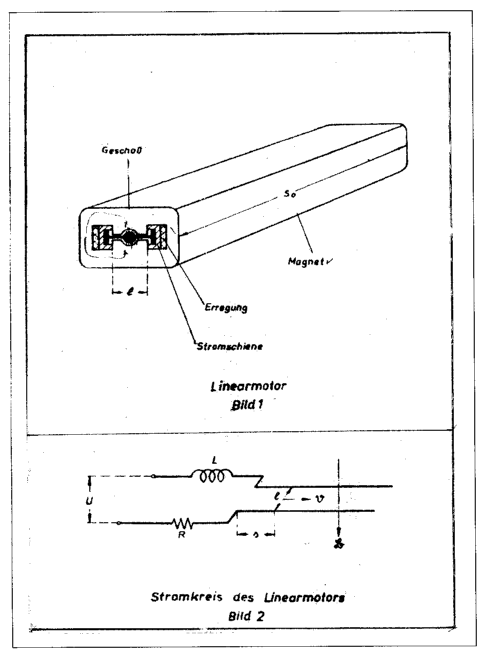
Railgun Design from Wikipedia Page
I think the page is not doing the theory behind railgun justice. So hopefully someone will make proper correction to the page with good reference to the actual design.
Also there is no reason to use permanent magnets. Electromagnets can be used to generate very large fields, even stronger than a permanent magnet, around the rails.
AND now those LOADs of power supplied to the projectile would make HUGE force moving it forward. I may try and see how far I can take this railgun.
Here are some other things I learned playing with the railgun:
- The projectile gets very hot and if it is made of metal, it can easily melt and weld itself to the rails. You either use something like carbon rods that don’t weld to the rails, or provide so much power that the projectile melts at the point of contact and moves forward on a bed of lava.
- The carbon rod leaves a trace of carbon on the rails that makes them less conductive. So the rails need cleaning.
- It helps if the rails are made of something that doesn’t melt! My rails have burn and melt marks all over! It makes the rails rough.
- The projectile placed on rails or between them vibrates and doesn’t make good contact. So it is good to have high voltages applied to it, the higher the better. Maybe a current limited high voltage supply would work. Because if the voltage is very high, the current would be very high too. And unless you are military, you won’t be able to supply that much! So with a current limited high voltage, when you have connection you have current, and when the connection breaks, the high voltage would arc over the gap and close the circuit. So with high voltage your circuit remains closed.
Good luck making your own! I may dig a bit dipper and make a proper one at some point.

Interesting to read! I got some very good info about the rail guns. Thanks for the share.
Good day sir, i liked your work after watching some of your videos. I love diy projects but most of the experiments i tried didn’t go successfully. So i’ll be really greatful when i’ve done this project well. The main issue i have is that i don’t have any strong magnet lying around my house for the rail schematic you showed. So i need to know how i can make the electromagnetic rail gun type since i have an enameled insulated copper wire lying around. Can you please give me the circuit diagram of how you are to use the electromagnetic method for the rail gun. I’ll be greatful for a quick reply. Thanks.
Hey I know this is late and you most likely wont reply / cant recall the answers but…
Could you tell us more about the magnets you use? Specifically, what strength are they rated and how are they arranged?
I study a wide range of items and one of them is magnetics. A good magnet to use is N45 or N52 neodymium magnets. The gauss rating is 8,000. (rounded) The configuration, well I can’t tell you that but for me If has worked if the magnet poles are facing the same direction with the same orientation.
Like so.
All north or south poles facing upwards
Or
All north or south poles facing downwards.
Thanks,
Scientist Smith
Hello, I’m getting very confused over your right hand rule, because what you taught was different than everywhere else. Many other places had index finger for magnetic fields and middle finger for current, could you please confirm? Those two fingers switching position changes the direction of motion vector completely.
Were they using their left hand?
Students in China use their left hand to remember the Fleming’s right-hand rule,but actually they are the same rules
Hi Mehdi, I believe this is quite important, so please don’t ignore me.
You see, a Spanish-speaking page posted a compilation of you on Facebook and they’re getting a ton of views, just telling you, since I really don’t think it’s okay that people randomly steal fragments of your vids, post them on facebook, get a ton of attention and somehow end up making advertisement money with them or getting public especially without giving you the credit, here’s the link https://www.facebook.com/EresTodoUnLoquillo/videos/747394898732410/?hc_ref=NEWSFEED
Hi mehdi sadaghdar I’m from Iran and I have some questions
If you use telegram it’s my phone number
09902251945
Please answer my questions in telegram
The video has Just been taken off YouTube. Why?
I’ll put it back soon. The sponsor wants me to remove their name from the video because it has political content.
Just for conveniance reasons:
They talk about a projectile (Geschoß), an excitation (Erregung), and the current rail (Stromschiene).
On the lower Image you see the circuit (Stromkreis) of a linear motor, which from my undrestanding is a series wound motor
I seriously doubt that the navy used 110v ac lol
Awesome
Pingback: The Science Behind Railguns
It is quite interesting to point out that in China we were instead taught to use Left Hand’s Rule for Lorenz force, that the magnetic field direction goes through the left hand’s palm.
Damn that will be a lot of annotation works in my captions.
LOL, i’ll never forget what fingers represent now!
Pingback: Making a Railgun - Trendy Rave
Pingback: The Latest: Making a RailgunKALEINAR.COM -